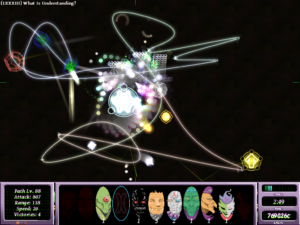Wizardry III: Character Creation
So, let’s talk about character creation a little, because that’s something I’ve been doing a lot of. This is something that doesn’t change at all in the first three Wizardry games, because all character creation for the first three games is done in Wizardry 1, even if you’re creating a character to use solely in one of the sequels.
Like most early CRPGs, Wizardry draws heavily from D&D. You’ve got the same four basic character classes (fighter, mage, priest, thief), and a set of six stats that are basically the same as D&D‘s but with different names — the only real difference is that Charisma has been dropped in favor of Luck. In early editions of D&D, stats ranged from 3 to 18 because they were generated by rolling three six-sided dice. Wizardry uses a point-buy system instead, but it still makes 18 the maximum out of sheer conceptual inertia.
The creation process goes like this: First you choose a name, then you choose a race, then you assign points to stats, then you choose a class, then you decide whether to keep the character or throw it away and start over. Aside from the name, which could easily have been made the last step, the mechanics pretty much dictate that it has to go in this order. You need to choose the class after finalizing the stats because the stats determine what classes are available, and you need to assign the stats after choosing the race because the race determines the base stats. Dwarves, for example, always start with Strength 10, IQ 7, Piety 10, Vitality 10, Agility 6, and Luck 6. Hobbits 1Yes, it’s “hobbit” here, not “halfling”. This game was made before the Tolkien estate’s lawyers became the all-seeing eye of flame that they are today. have the highest total initial stats, which you might think would make them an attractive choice, but in fact it’s mostly in Luck, the least-attractive stat.
Every character class has a requirement of at least 11 in some stat: fighters need 11 Strength, priests need 11 Piety, etc. In addition to the base classes, there’s an odd assortment of specialized classes: Bishop, Samurai, Lord, and Ninja. (Yes, this means you can have dwarven and gnomish samurai, which is an entertaining thing to contemplate.) Samurai are fighter/mages, Lords are fighter/priests (in other words, paladins), and Ninjas are unarmed combat specialists who randomly do instant kills. (I have a habit of thinking of Ninjas as fighter/thieves, which would make a nice symmetry, but it isn’t really accurate.) Bishops are combination priest/mages, with the additional ability to identify items. They’re generally considered weaksauce, because they don’t gain higher spell levels as fast as the pure priests and mages, but I’m finding them tremendously useful at level 1, where they can cast four spells before running out of slots, compared to the normal caster’s two. Presumably because of this early usefulness, Bishops are the one special class you can reliably make as a new level 1 character, with stat requirements of just 11 IQ and 11 Piety. Lords and Ninjas are basically impossible to generate at level 1, and can only be produced by changing a character’s class after a number of stat increases from gaining experience levels — in particular, Ninjas require a 17 in every stat.
Samurai, now. Samurai can be produced at initial creation, but only occasionally. This is because the number of points you get to assign to stats is randomized. From the base stats for dwarves, elves, and gnomes, it takes 18 points to meet the Samurai requirements; getting this many points to spend is rare, but it does happen every once in a while. Furthermore, the randomization is oddly irregular; it usually stays between 5 and 11, but occasionally leaps to 18 or 19, and I’ve even seen a 26 come up. This is a design decision that it would be strange to see today. Random factors are all very well for transient events like combat, but for a single dice-roll to affect a character’s options from the very beginning like this is to invite the player to reroll over and over until they get what they want. This is the problem with random generation that point-buy is usually supposed to solve. So it’s very strange to see a point-buy system that goes to extra effort to bring the problem back. Maybe the authors felt that rerolling characters was an important part of the RPG experience.
| ↑1 | Yes, it’s “hobbit” here, not “halfling”. This game was made before the Tolkien estate’s lawyers became the all-seeing eye of flame that they are today. |
|---|
 Comments(0)
Comments(0)